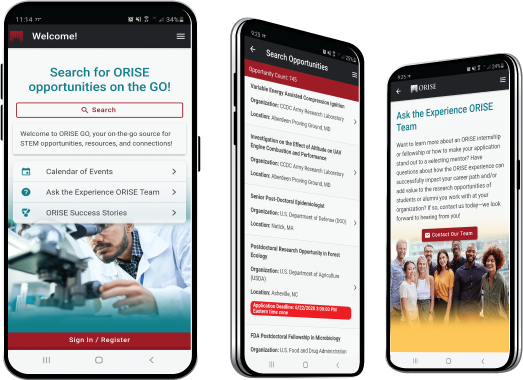Mathematical Modeling Data Scientist
A complete application consists of:
-
An application
-
Transcripts – Click here for detailed information about acceptable transcripts
-
A current resume/CV, including academic history, employment history, relevant experiences, and publication list
-
Two educational or professional references
All documents must be in English or include an official English translation.
If you have questions, send an email to EPArpp@orau.org . Please include the reference code for this opportunity in your email.
A research opportunity is currently available at the U.S. Environmental Protection Agency’s (EPA) Office of Research and Development (ORD) National Center for Computational Toxicology (NCCT). This appointment will be served at the EPA Main Campus in Research Triangle Park, North Carolina.
The National Center for Computational Toxicology (NCCT) and Rapid Exposure and Dosimetry (RED) project are both comprised of scientists, technologists, post docs, and student researchers with backgrounds from diverse scientific disciplines.
The NCCT is responsible for developing new computational tools and providing quantitative analysis for improving environmental risk assessments and regulatory decisions pertaining to chemical safety and sustainability (http://epa.gov/ncct/). There are tens of thousands of chemicals that are currently in commerce, with hundreds more introduced every year. Many of these chemicals find their way into the environment and only a small fraction have been adequately assessed for potential risk. The NCCT is working with its partners to revolutionize how we assess chemical toxicity risk to humans and the environment.
The RED project team, led by John Wambaugh and Kristin Isaacs, works to increase the pace and effectiveness at which relevant information on chemicals with environmental exposures can be obtained. Estimates of human and ecological exposures are required as critical input to risk-based prioritization and screening of chemicals. Our project seeks to develop the data, tools, and evaluation approaches required to generate rapid and scientifically-defensible exposure predictions for the full universe of existing and proposed commercial chemicals.
The participant will be involved in some of the following training activities addressing critical environmental protection needs:
-
Bayesian evaluation of the predictive ability of mathematical models for chemical exposure using environmental monitoring data (e.g., surface water concentrations)
-
Inference of loading of environmental chemicals into U.S. waterways using exposure models and water sampling data
-
Implementation, parameterization, and revision of mathematical models for chemical exposure
-
Informatics and “Big Data” analytics using machine learning approaches
-
Predicting relevant exposure pathways for individual chemicals from structure features
-
Assessing domain of applicability for chemical property predictors using data from high throughput property measurements and quantitative-structure activity relationships (QSARs)
-
Parallelize and otherwise refine model calculations to best use multi-core computer resources.
-
Review evidence from the literature and NCCT databases in order to develop hypotheses and identify data sets for evaluating and revising models.
The participant will be mentored by John Wambaugh. Collaborating research contributers will include investigators from NCCT (Drs. Woodrow Setzer, Antony Williams, Chris Grulke, Richard Judson, Ann Richard, and Rusty Thomas) and the National Exposure Research Laboratory (Drs. Kristin Isaacs, Jon Sobus, Katherine Phillips, Mark Strynar, Dan Vallero, Paul Price, Elin Ulrich, Peter Egeghy, Craig Barber, and Cecilia Tan). The participant will have latitude in exercising independent initiative and judgment in the research commensurate with the level of training.
This program, administered by ORAU through its contract with the U.S. Department of Energy to manage the Oak Ridge Institute for Science and Education, was established through an interagency agreement between DOE and EPA.
The appointment is full time for one year and may be renewed upon recommendation of EPA and contingent on the availability of funds. The participant will receive a monthly stipend. Funding may be made available to reimburse the participant’s travel expenses to present the results of his/her research at scientific conferences. No funding will be made available to cover travel costs for pre-appointment visits, relocation costs, tuition and fees, or participant’s health insurance. The participant must show proof of health and medical insurance. The participant does not become an EPA employee.
The mentor for this project is John Wambaugh (wambaugh.john@epa.gov). The desired start date for this appointment is December 15, 2017.
Applicants must be accepted to pursue a graduate degree in environmental or physical sciences at an accredited university or other degree granting institution. The applicant must be generally knowledgeable in at least one of the following fields: environmental science, environmental engineering, biomedical engineering, applied statistics, applied mathematics, and/or physics. The ideal applicant would be proficient and have a demonstrated interest in one or more of the following field: mathematical models of chemical exposure, statistical analysis including Bayesian methods, environmental chemistry.
Through this project, the participant will gain education and training in the general areas of environmental chemistry, mathematical modeling, statistical analysis, computational toxicology, and exposure science. Prior experience in these areas would clearly be of value. Research findings will be communicated through peer-reviewed publications, national meetings of professional societies, and work-in-progress seminars. The training the participant will receive, coupled with a productive publishing record, should make it possible for them to move into any of these areas or continue down a transdisciplinary path at their discretion. The research participant will be involved in highly visible computational exposure research and engaged with researchers world-wide. S/he will be published in peer-reviewed journals and present research results at local and national meetings.
- Degree: Master's Degree or Doctoral Degree.
- Discipline(s):

 ORISE GO
ORISE GO

The ORISE GO mobile app helps you stay engaged, connected and informed during your ORISE experience – from application, to offer, through your appointment and even as an ORISE alum!





